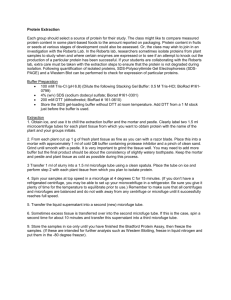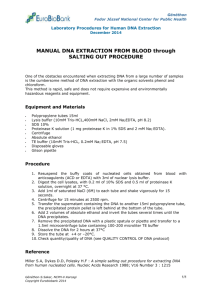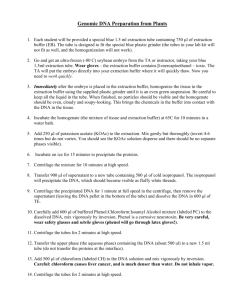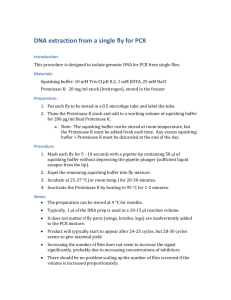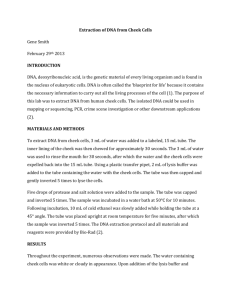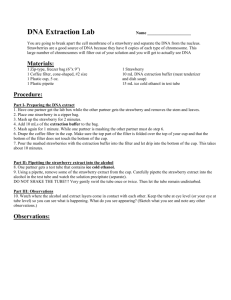NRL003 Anisakis DNA Extraction Method
advertisement
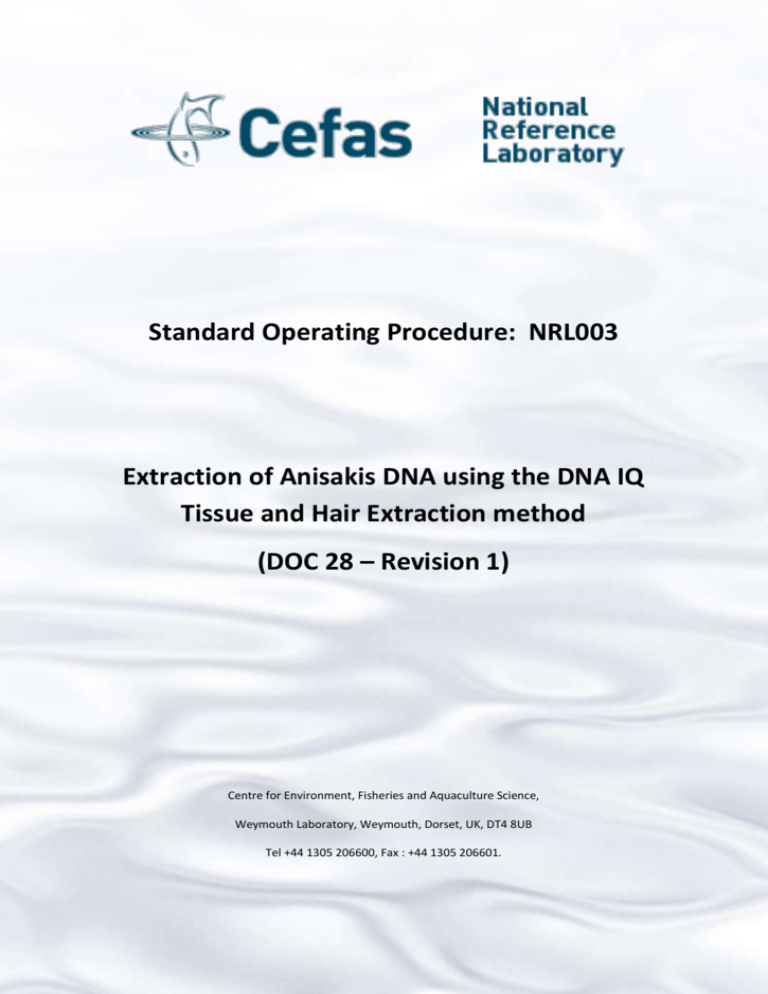
Standard Operating Procedure: NRL003 Extraction of Anisakis DNA using the DNA IQ Tissue and Hair Extraction method (DOC 28 – Revision 1) Centre for Environment, Fisheries and Aquaculture Science, Weymouth Laboratory, Weymouth, Dorset, UK, DT4 8UB Tel +44 1305 206600, Fax : +44 1305 206601. Page 1 of 8 NRL003 Extraction of Anisakis DNA using the DNA IQ Tissue and Hair Extraction method – DOC28 Revision 1 Printed versions of this document are uncontrolled unless signed by the Quality Department Page 2 of 8 NRL003 Extraction of Anisakis DNA using the DNA IQ Tissue and Hair Extraction method – DOC28 Revision 1 Printed versions of this document are uncontrolled unless signed by the Quality Department Version Control Submitted to: Date submitted Project manager Document compiled by: Quality control by: Approved by and date: Version: Steve Feist 8/1/2015 Steve Feist Rose Kerr Steve Feist Steve Feist 8/1/2015 1.3 Author Date Comment Version Rose Kerr 8/1/2015 DRAFT 1.1 Steve Feist 8/1/2015 Approved 1.2 Tom Hill 8/10/2014 Saved to contracts drive 1.3 Tom Hill 25/6/2015 Version control added and uploaded to QPulse as ‘DOC28 - Revision 1’ DOC28 Revision 1 Page 3 of 8 NRL003 Extraction of Anisakis DNA using the DNA IQ Tissue and Hair Extraction method – DOC28 Revision 1 Printed versions of this document are uncontrolled unless signed by the Quality Department Introduction The Tissue and Hair extraction kit for use with the DNA IQ system is used for the extraction of total DNA. Specifically the use of Dithiothreitol (DTT) in the IPD (Incubation buffer, Proteinase K and DTT) mix in the initial incubation reduces disulfide bonds to dithiols, which results in the external proteins breaking down. An Anisakid worm will be digested into a liquid at this stage. Further lysis of internal proteins occurs via the use of excess Proteinase K in the lysis buffer stage. This results in a more complete release of total DNA into solution which is precipitated using Isopropyl alcohol and ETOH washing stages and finally eluted into molecular grade water. Scope This standard operating procedure covers the specific lysis and extraction of Anisakis ssp DNA only. Equipment Nitrile gloves Laboratory coat Variable volume pipettors p10, p100, p200, p1000 and associated tips (eg Rainin pipet lite XLS) Plastic autoclaved racks Mini centrifuge (eg Stuart Spinner SCF1 Bibby Scientific) Vortexer (eg Stuart SA8 Bibby Scientific) Magnetic stand Waste bag 500ml beaker 0.5ml PCR tubes 1.5ml microfuge tubes Universals Fume cupboard Extraction cabinet (Labconco purifier PCR enclosure) Page 4 of 8 NRL003 Extraction of Anisakis DNA using the DNA IQ Tissue and Hair Extraction method – DOC28 Revision 1 Printed versions of this document are uncontrolled unless signed by the Quality Department Fridge in room 213(Moff 7) (small) Freezer room 213 Variable temperature heat block Centrifuge (Heraeus Biofuge Pico) Chemicals 99% absolute ETOH 70% ETOH in a spray bottle 1% Virkon (1 tablet in 500mls H20) in a spray bottle Molecular grade H20 Isopropyl alcohol Tissue and Hair Extraction Kit (for use with DNA IQ). Part# TB307 containing: 100mg Proteinase K powder 5g DTT powder 2 x Wash buffer concentrate Lysis buffer Incubation buffer Resin Elution buffer Page 5 of 8 NRL003 Extraction of Anisakis DNA using the DNA IQ Tissue and Hair Extraction method – DOC28 Revision 1 Printed versions of this document are uncontrolled unless signed by the Quality Department Method The following procedures take place in room 213. A laboratory coat and gloves must be won for all stages. Prior to undertaking the DNA extraction the following buffers must be made up: Proteinase K, DTT, IB/ProtK/DTT mix, Wash buffer, Lysis buffer. Clean cabinet (A, B or C) and associated pipettes, mini centrifuge and vortexer using 1% Virkon solution followed by 70% ETOH with paper towel. UV the cleaned cabinet for 5 minutes. After the UV has switched off place in the cabinet a waste bag, gloves, pipette tips (p10, p200, p1000), and switch on the UV for 5 minutes. To make the Proteinase K solution: Pipette 5.5ml of Incubation Buffer into 100mg Proteinase K powder, vortex to dissolve, and pipette into 100µl volumes. Store the labelled tubes at -20oC. The concentration of each aliquot of Proteinase K is 18mg/ml. To make the DTT, in a fume cupboard pipette 32.4ml of molecular grade water into the 5g of DTT powder and shake until dissolved. Pipette 250µl volumes into 0.5ml labelled microfuge tubes and freeze at -20oC. To make the IPD buffer (IB / Proteinase K / DTT), the following liquids were mixed in the following proportions: 8 parts Incubation buffer (IB) (eg 800µl), 1 part Proteinase K (eg 100µl) and 1 part DTT (eg 100µl) in a 1.5ml microfuge tube. This mix must be made up freshly prior to each use. To make the Wash Buffer pipette 15ml of Isopropyl alcohol and 15ml of 99% absolute ETOH into the 2 x Wash Buffer concentrate and mix and stored at room temperature. To make the Lysis Buffer, pipette 1µl of DTT per 100µl of Lysis Buffer. The buffer can then be stored at room temperature for 1 month. Clean cabinet (A, B or C) and associated pipettes, mini centrifuge and vortexer using a 1% Virkon solution followed by 70% ETOH with paper towel. UV the cleaned cabinet for 5 minutes. After the UV has switched off place in the cabinet a waste bag (in the 500ml beaker), gloves, pipette tips (p10, p200, p1000), labelled 1.5ml microfuge tube (one for each sample), autoclaved tube rack containing labelled 0.5ml PCR tubes, one for each sample. Also place in the cabinet a universal container labelled ‘waste’ and the magnetic stand. Switch the UV back on for a further 5 minutes. Take the microfuge tube (s) containing the worm (s) from the fridge and place in the cabinet. Pipette off the ETOH from the worm into the waste universal container. Using a pipette tip flick the worm into the labelled 1.5ml microfuge tube. Pipette 100µl of IPD buffer into the microfuge tube containing the worm, and incubate at 55oC, in the heat block in 213, for 2 hours, vortexing every 30 minutes. Centrifuge the sample briefly and pipette 200µl of Lysis Buffer into the sample. Then pipette 10µl of thoroughly vortexed resin. Incubate the sample for 10 minutes at 25oC on the heat block, vortexing regularly. Place the sample in the magnetic stand and once the resin has separated out from the liquid Page 6 of 8 NRL003 Extraction of Anisakis DNA using the DNA IQ Tissue and Hair Extraction method – DOC28 Revision 1 Printed versions of this document are uncontrolled unless signed by the Quality Department and stuck to the side of the tube pipette off the Lysis Buffer. Add another 100µl Lysis Buffer to the microfuge tube and remove from the magnetic stand. Vortex the sample briefly, place the microfuge tube containing the sample back in the magnetic stand, wait for the resin to stick to the magnet and pipette off the Lysis buffer as before. Remove the microfuge tube from the magnetic stand. Add 100µl of Wash Buffer and vortex the sample to resuspend the resin, place the microfuge tube back onto the magnetic stand and wait for the resin to stick to the side of the tube. Pipette off the buffer, place the tube back into the stand and repeat the wash buffer steps a further two times. After the last wash leave the tube in the magnetic stand with the lids open to air dry for 15 minutes. Remove the microfuge tube from the stand and pipette 25µl of Elution Buffer into the microfuge tube and incubate the sample at 65oC for 5 minutes with vortexing. Place the microfuge tube into the magnetic stand and wait for the resin to stick to the side of the tube. Using a P200 pipette, remove the 25µl eluate from the tube and pipette into a labelled 0.5ml PCR tube and store until required in the -20oC freezer. Return all the items left in the cabinet to their storage locations and re clean the cabinet with 1% Virkon followed by 70% ETOH. Review Yearly. References Tissue and Hair Extraction Kit (for use with DNA IQ). Part# TB307 Promega technical bulletin. Revised 6/12. DNA IQ system small sample casework protocol. Part# TB296 promega technical bulletin. Revised 11/13. Identification of Anisakidae larvae at the species level by multiplex PCR. European Union Reference Laboratory for Parasites. Department of Infectious, Parasitic and Immunomediated diseases. Unit of Gastroenteric and Tissue Parasitic Diseases. Istituto Superiore di Sanita. Page 7 of 8 NRL003 Extraction of Anisakis DNA using the DNA IQ Tissue and Hair Extraction method – DOC28 Revision 1 Printed versions of this document are uncontrolled unless signed by the Quality Department Page 8 of 8 NRL003 Extraction of Anisakis DNA using the DNA IQ Tissue and Hair Extraction method – DOC28 Revision 1 Printed versions of this document are uncontrolled unless signed by the Quality Department
